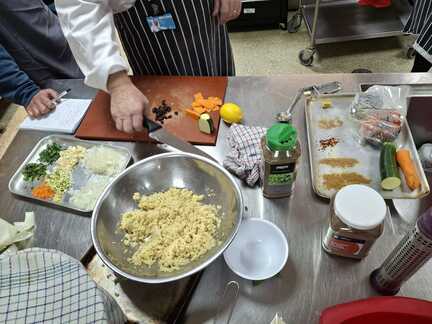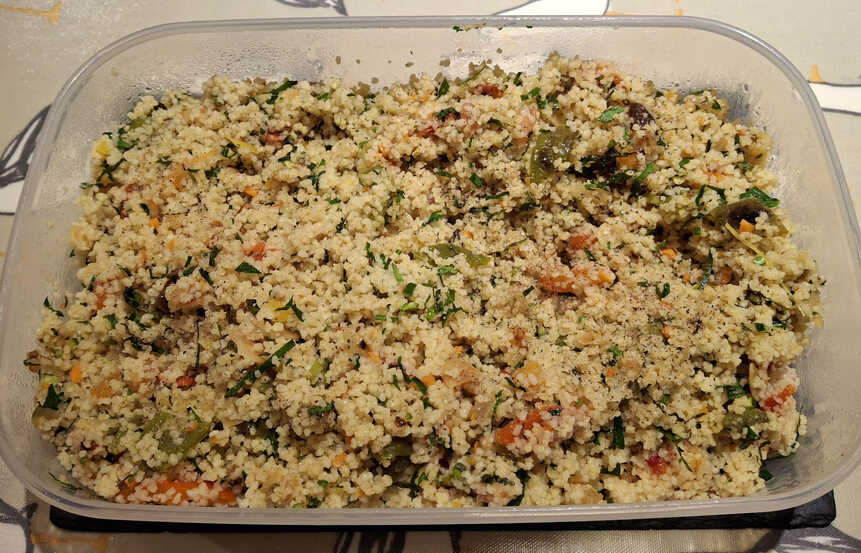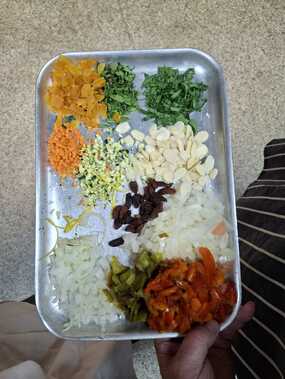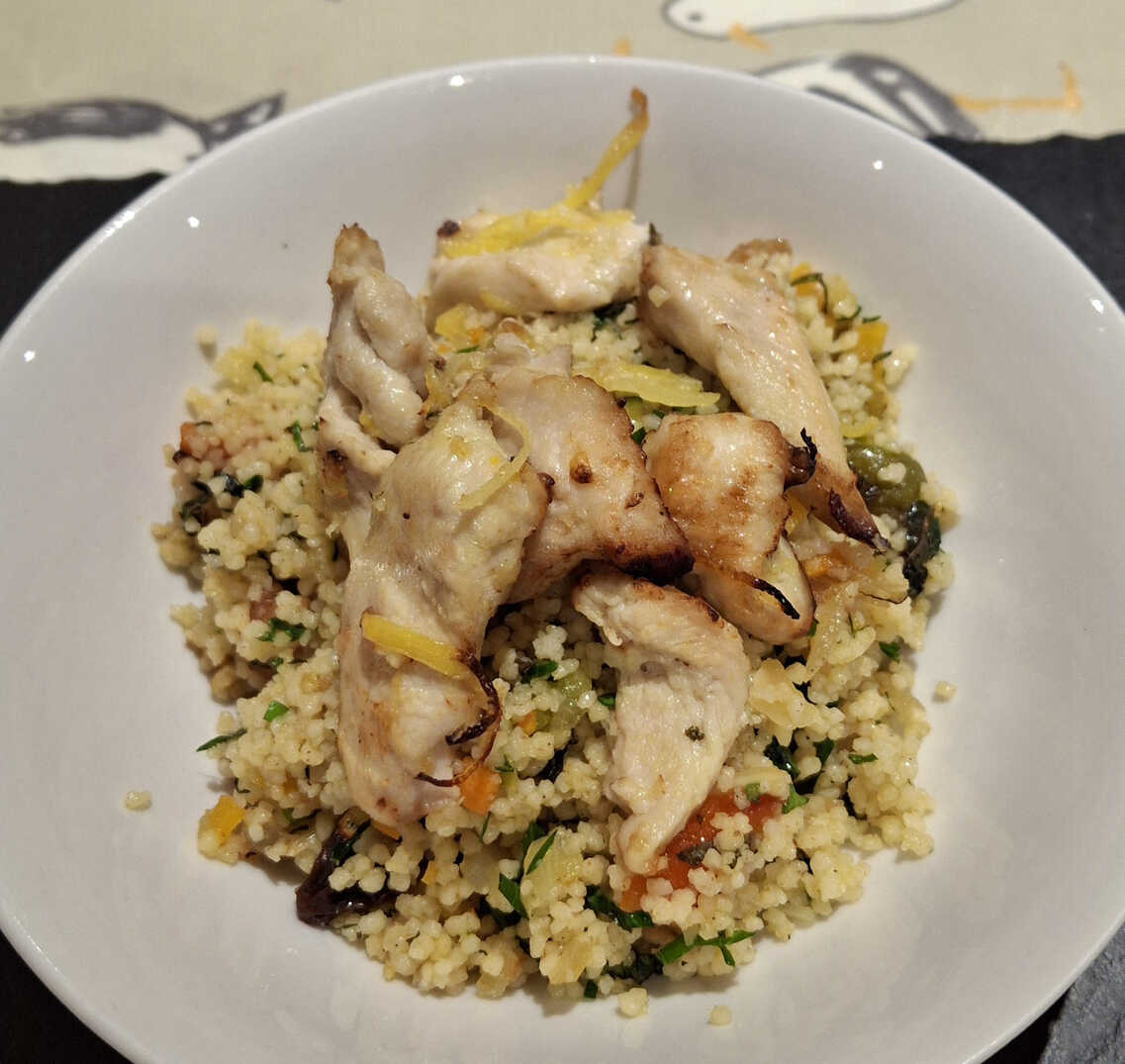Street Food 3 - Couscous
Couscous is actually a kind of pasta, being made by rolling durum wheat semolina into tiny balls, although versions can also be made from other grains such as barley, millet or even cornmeal or cassava.
But is it Street Food?
I mean, on its face, street food is any food which is, or could be, sold by a street-side vendor and eaten by customers on the street. Though I would also add whilst walking.
Could this include food you need a knife and fork, or a spoon to eat? I'd say probably not.
I guess this allows in soup, for which you don't technically need a spoon - you can just slurp it straight out of a bowl or mug.
But couscous? I think no.
More importantly however, whether you agree with my definition or not: Is couscous actually served somewhere as a street food?
It would seem not.
You can buy couscous in market cafés all across North Africa, but as far as I can tell without having been there, it's generally eaten at a table whilst sitting down.
So not Street Food then.
Of course we all still had great fun making it 🙂
When made by hand the semolina is mixed with a little water, rolled around a bowl or a woven basket and then sieved to filter out grains too large or small.
This traditional, un-cooked, couscous must then be steamed in a couscoussier over a broth which is often simultaneously cooking the meat or vegetables to be served with the dish. It's a fairly lengthy, fiddly, process since it's done in three steamings or tafwira of about 20 minutes each, in-between which the couscous is emptied out of the steamer, rubbed with oil and salt to break up any lumps, and moistened with additional water.
The couscous generally available in the UK, outside of speciality stores, is an instant, fascinatingly complex-machine-made version of couscous that has already been pre-steamed and dried.
Instant Couscous only needs to be covered with (or dumped into) boiling water and left to hydrate for about 10 minutes. The volume of water required varies from 1 to 1½ times the volume of couscous depending on the brand.
Which version to serve? You decide!
Our class chose Instant.
But is it Street Food?
I mean, on its face, street food is any food which is, or could be, sold by a street-side vendor and eaten by customers on the street. Though I would also add whilst walking.
Could this include food you need a knife and fork, or a spoon to eat? I'd say probably not.
I guess this allows in soup, for which you don't technically need a spoon - you can just slurp it straight out of a bowl or mug.
But couscous? I think no.
More importantly however, whether you agree with my definition or not: Is couscous actually served somewhere as a street food?
It would seem not.
You can buy couscous in market cafés all across North Africa, but as far as I can tell without having been there, it's generally eaten at a table whilst sitting down.
So not Street Food then.
Of course we all still had great fun making it 🙂
When made by hand the semolina is mixed with a little water, rolled around a bowl or a woven basket and then sieved to filter out grains too large or small.
This traditional, un-cooked, couscous must then be steamed in a couscoussier over a broth which is often simultaneously cooking the meat or vegetables to be served with the dish. It's a fairly lengthy, fiddly, process since it's done in three steamings or tafwira of about 20 minutes each, in-between which the couscous is emptied out of the steamer, rubbed with oil and salt to break up any lumps, and moistened with additional water.
The couscous generally available in the UK, outside of speciality stores, is an instant, fascinatingly complex-machine-made version of couscous that has already been pre-steamed and dried.
Instant Couscous only needs to be covered with (or dumped into) boiling water and left to hydrate for about 10 minutes. The volume of water required varies from 1 to 1½ times the volume of couscous depending on the brand.
Which version to serve? You decide!
Our class chose Instant.
Teacher Paul selected a range of suitable fillings is that the right word? for his couscous, including mint and parsley which is a fairly unusual combination of herbs.
You do notably find them in Tabbouleh - a Middle Eastern salad of parsley, mint, bulgur wheat, tomato, onion, lemon and olive oil - a sample of which one of our Syrian classmates was kind enough to make up for us.
It's not too dissimilar to the couscous dish we ended up making, except that tabbouleh is basically a parsley salad and contains very little bulgur. And traditionally only the ingredients listed.
We also grilled up some delicious lemon garlic chicken to go on top. Because otherwise couscous is a bit boring.
Notable PaulPointers™ of the week:
You do notably find them in Tabbouleh - a Middle Eastern salad of parsley, mint, bulgur wheat, tomato, onion, lemon and olive oil - a sample of which one of our Syrian classmates was kind enough to make up for us.
It's not too dissimilar to the couscous dish we ended up making, except that tabbouleh is basically a parsley salad and contains very little bulgur. And traditionally only the ingredients listed.
We also grilled up some delicious lemon garlic chicken to go on top. Because otherwise couscous is a bit boring.
Notable PaulPointers™ of the week:
- An intriguing suggestion for marinating fish in lemon (and herbs?) before battering and frying - much like the lemon chicken below.
Interestingly, award-winning chef Nathan Outlaw would roll his fish fillets in lemon zest and chopped herbs before battering and frying them at The Goring Hotel. - Salting the oiled skin of peppers before charring makes the skin easier to remove. Maybe.
- Adding a little honey to couscous introduces a well-suited and very pleasant sweetness.
menu
Carbs
Couscous
MEAT
Lemon Garlic Chicken
Couscous
With diverse vegetables, herbs and spices.
MEAT
Lemon Garlic Chicken
A Levantine favourite.
Couscous
staple veg vegan
Teacher Paul explained that he wanted us to experience the process of developing a couscous dish on the fly.
Which is why he didn't have a recipe or a plan.
At least, that's his story!
I've enumerated an approximation below of the ingredients Paul assembled but all are optional - tailor them to whatever you fancy. It's quite hard to go wrong, frankly.
Which is why he didn't have a recipe or a plan.
At least, that's his story!
I've enumerated an approximation below of the ingredients Paul assembled but all are optional - tailor them to whatever you fancy. It's quite hard to go wrong, frankly.
Serves 4
Ingredients
- 1 cup couscous
- 1½ cup boiling stock or water
Optional Spices:- 2 tsps ground coriander
- 1-2 tsps ground cumin
- ½-1 tsp dried chilli flakes double optional
- 1 tsp paprika
- 2 tsps dried thyme or oregano
- 1 tsp ground black pepper
Fillings:- ½ onion, finely chopped
- 2" carrot, brunoise
- 3" courgette, brunoise
- 1-2 tblsps honey
- handful mint, chopped
- handful parsley, chopped
- 2 tomatoes, peeled, cored, chopped
- 2 bell peppers, charred, peeled, deseeded, chopped
- 1 chilli, charred, peeled, deseeded, chopped optional
- handful almond flakes, toasted
- half a dozen dried apricots, minced
- handful sultanas
- spring onions, sliced
Bring enough stock or water to the boil to provide 1½ times the volume of couscous you have.
Roll the bell peppers in oil to coat, sprinkle with a generous amount of salt, and put them under a hot grill.
Immediately drop the peppers into a plastic bag, seal, and set aside to cool. Afterwards the skins should rub away from the flesh quite easily. Remove the core and the seeds, and cut the flesh into 1cm lozenges. Keep any exuded pepper juices to flavour the couscous, but use cautiously since they may be very salty.
Mince the onion, chop the herbs, turn the carrot and the courgette into a fine dice or brunoise, chop the apricots, roughly chop the sultanas if they're too large, concasse the tomatoes.
Choose a collection of spice powders, and dried herbs if you don't have the fresh variety. We had dried thyme, but oregano would be nice, and fresh thyme or oregano even better 😉
When everything is ready, heat olive oil in a frying pan and sweat the onion, carrot and courgette until softened, then throw in the ground spices and dried herbs you've selected.
Mix well until any raw or bitter aromas have cooked off the spices.
Off the heat, stir through a tablespoon or two of honey.
Now fluff up the couscous with a fork and mix in the fillings, or whatever you call the stuff you just prepared, into it. Be careful with the pepper juices, which might be too salty, but then adjust the seasonings and add more olive oil if you feel it needs it.
Roll the bell peppers in oil to coat, sprinkle with a generous amount of salt, and put them under a hot grill.
I like to cut them in half and put them under the grill skin-side up which requires less turning and gives more even grilling.
Apparently the salt will help the peel to separate more easily later.
Turn them occasionally until the skin is thoroughly well-charred. Don't worry - unless you're seeing actual flames it's quite difficult to over-char.
Do the same with a chilli pepper or two if you like.Apparently the salt will help the peel to separate more easily later.
Immediately drop the peppers into a plastic bag, seal, and set aside to cool. Afterwards the skins should rub away from the flesh quite easily. Remove the core and the seeds, and cut the flesh into 1cm lozenges. Keep any exuded pepper juices to flavour the couscous, but use cautiously since they may be very salty.
Mince the onion, chop the herbs, turn the carrot and the courgette into a fine dice or brunoise, chop the apricots, roughly chop the sultanas if they're too large, concasse the tomatoes.
You can blanch the tomatoes to more easily remove their skin: Cut around the core, cut a small cross into the opposite pointy side and plunge the tomato into boiling water for 30-60 seconds, then chill in cold water.
Now pull off the skin, cut into segments, de-core and de-seed so you're left with just the flesh.
Alternatively segment the tomato to begin, then cut away the seeds and core, and with your knife flat along the cutting board slice away the skin as you would for salmon.
Cut the flesh you're left with into small diamonds.
Toast the almond flakes in a dry frying pan or under the grill.Alternatively segment the tomato to begin, then cut away the seeds and core, and with your knife flat along the cutting board slice away the skin as you would for salmon.
Cut the flesh you're left with into small diamonds.
Choose a collection of spice powders, and dried herbs if you don't have the fresh variety. We had dried thyme, but oregano would be nice, and fresh thyme or oregano even better 😉
When everything is ready, heat olive oil in a frying pan and sweat the onion, carrot and courgette until softened, then throw in the ground spices and dried herbs you've selected.
Mix well until any raw or bitter aromas have cooked off the spices.
Off the heat, stir through a tablespoon or two of honey.
Now fluff up the couscous with a fork and mix in the fillings, or whatever you call the stuff you just prepared, into it. Be careful with the pepper juices, which might be too salty, but then adjust the seasonings and add more olive oil if you feel it needs it.
If you wanted to make this in one pot, you could fry the onions, brunoise and spices in a large pot, add stock and boil, then add just the right volume of couscous and leave to hydrate.
Top with lemon garlic chicken if you've marinated any,
sliced spring onions if you have any and toasted almond flakes for bonus presentation points 🙂
It's fine. Couscous is a forgiving and versatile staple which you can enhance with more-or-less anything.
Except maybe for pussy.
Lemon Garlic Chicken
fowl main
As Teacher Paul was keen to impart to us, lemon and garlic flavours go magnificently well with chicken, something the Greeks and the Levantines have long known.
Unfortunately he spent so long extolling their virtues that we didn't end up with any time left to actually marinate the chicken in them.
The Lebanese might add yoghurt and za'atar or 7-spice Sabaa Baharat powder, Moroccans would probably throw in a few olives and perhaps their lemons would be of the preserved variety, and the Greeks would almost certainly include oregano or thyme leaves, but they do all love their lemon chicken.
Just be aware, if you add any additional ingredients yourself, that they may well burn when you ferociously grill the chicken.
Unfortunately he spent so long extolling their virtues that we didn't end up with any time left to actually marinate the chicken in them.
The Lebanese might add yoghurt and za'atar or 7-spice Sabaa Baharat powder, Moroccans would probably throw in a few olives and perhaps their lemons would be of the preserved variety, and the Greeks would almost certainly include oregano or thyme leaves, but they do all love their lemon chicken.
Just be aware, if you add any additional ingredients yourself, that they may well burn when you ferociously grill the chicken.
Serves 4
Ingredients
- 2 skinless chicken breasts, cut into strips
- zest and juice of 1 lemon
- 2-3 garlic cloves, crushed
- olive oil
- salt & pepper.
Slice off the lemon zest in fat strips you can use a potato peeler, though try to avoid including too much bitter pith, then shred finely into a chiffonade.
Juice the now strangely naked lemon.
Crush the garlic. You can do this quite effectively by smashing the clove, skin-and-all, with a blow to the flat side of chef's knife. Then pick out the skin, roughly chop the flesh, and smear the flesh to a purée along the rough surface of a chopping board with the knife edge held at an angle.
Slice the chicken breasts into strips or escalopes. You can cut these at an angle to increase their surface area.
Griddle or grill at high heat, turning, until the chicken is cooked through and picks up some charring around the edges.
Juice the now strangely naked lemon.
Crush the garlic. You can do this quite effectively by smashing the clove, skin-and-all, with a blow to the flat side of chef's knife. Then pick out the skin, roughly chop the flesh, and smear the flesh to a purée along the rough surface of a chopping board with the knife edge held at an angle.
Slice the chicken breasts into strips or escalopes. You can cut these at an angle to increase their surface area.
I like fat strips, so I cut the breasts into escalopes, then halve these lengthwise if they're very wide.
Paul likes this bias-cut method because it makes the chicken look bigger, which allows him to serve his restaurant customers fewer.
(You know, the more I hear about his restaurant, the less I'd want to have eaten there - though it sounds like there was little choice in that regard 🤣)
Season the chicken and mix with the lemon zest and juice, garlic and a generous glug of olive oil.
Leave it to marinate for 30 mins to an hour, but don't overdo it - it's pretty much ready when the flesh turns white.
If you marinate it for too long it will turn to mush.Paul likes this bias-cut method because it makes the chicken look bigger, which allows him to serve his restaurant customers fewer.
(You know, the more I hear about his restaurant, the less I'd want to have eaten there - though it sounds like there was little choice in that regard 🤣)
Griddle or grill at high heat, turning, until the chicken is cooked through and picks up some charring around the edges.
An air-fryer on maximum (240°C in my case) for about 10-12 minutes does a great job. You'll probably need to do this in batches. And expect a lot of cleaning.
Serve up on couscous if you're Middle Eastern, or potatoes if you're Greek. Or rice if you're weird.
Excellent. Teacher Paul is not wrong about the harmoniousness of these ingredients.
You definitely might consider adding fresh thyme or oregano to the marinade though.
You definitely might consider adding fresh thyme or oregano to the marinade though.




Add a dash of olive oil too, if you want to lubricate the semolina kernels but are too lazy to stir it in afterwards.